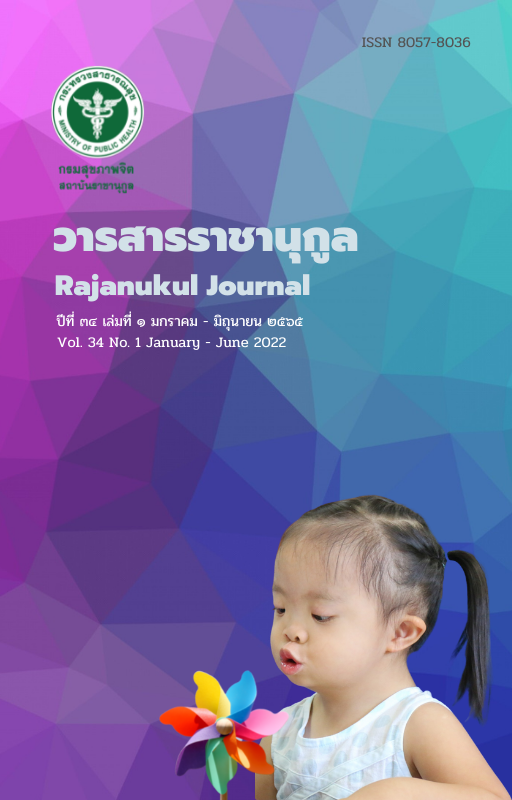เกมส่งเสริมทักษะการช่วยเหลือตัวเองและสังคมสำหรับเด็กออทิสติก
คำสำคัญ:
เกม , ทักษะการช่วยเหลือตนเองและสังคม , แท็บเล็ต , ออทิสติกบทคัดย่อ
วัตถุประสงค์ เพื่อศึกษาผลการใช้เกมส่งเสริมทักษะการช่วยเหลือตัวเองและสังคมบนอุปกรณ์แท็บเล็ตสำหรับเด็กออทิสติกในบริบทโรงเรียน
วัสดุและวิธีการ ออกแบบและพัฒนาเกมช่วยส่งเสริมทักษะการช่วยเหลือตัวเองและสังคมโดยประยุกต์ใช้ทฤษฎีการออกแบบโดยการมีส่วนร่วม (participatory design) โดยทั้งผู้เชี่ยวชาญด้านการออกแบบการแทรกแซงทางการแพทย์และการศึกษา ผู้เชี่ยวชาญด้านการออกแบบเกมและกราฟิก และเด็กออทิสติกมีส่วนร่วมในการออกแบบเกม นำเกมที่พัฒนาขึ้นบนระบบปฏิบัติการแอนดรอยด์สำหรับใช้งานบนแท็บเล็ตไปทดสอบกับกลุ่มตัวอย่างเด็กออทิสติกอายุระหว่าง 7-15 ปี ที่ศูนย์การศึกษาพิเศษประจำจังหวัด 2 แห่ง จำนวน 16 คน เป็นระยะเวลา 4 สัปดาห์ กลุ่มตัวอย่างเด็กออทิสติกเป็นผู้ทำกิจกรรมกับเกม โดยมีครูเป็นผู้ให้ความช่วยเหลือระหว่างที่กลุ่มตัวอย่างทำกิจกรรม ก่อนและหลังการทดลองนั้น ครูและผู้ปกครองของกลุ่มตัวอย่างประเมินกลุ่มตัวอย่างด้วยแบบทดสอบ ATEC (autism treatment evaluation checklists) และแบบประเมินทักษะการช่วยเหลือตัวเองและสังคมที่เกี่ยวข้องกับกิจกรรมในเกม วิเคราะห์ผลของการใช้เกมก่อนและหลังการทดลอง
ผล กลุ่มตัวอย่างเด็กออทิสติกเป็นชายร้อยละ 93.8 อายุเฉลี่ย 10 ปี (SD.= 2.12) มีผลคะแนนเฉลี่ยของแบบประเมินทักษะการช่วยเหลือตนเองและสังคมหลังการทดลองมากกว่าก่อนการทดลองอย่างมีนัยสำคัญทางสถิติที่ระดับ .05 ในบริบทโรงอาหารและบริบทรวม และกลุ่มตัวอย่างมีระดับความรุนแรงของอาการออทิซึม ซึ่งอ้างอิงจากคะแนนแบบประเมิน ATEC โดยเฉลี่ยลดลงแต่ไม่มีความแตกต่างอย่างมีนัยสำคัญทางสถิติ
สรุป แอปพลิเคชันเกมบนอุปกรณ์แท็บเล็ตสามารถใช้เป็นเครื่องมือช่วยส่งเสริมให้เด็กออทิสติกเกิดการเรียนรู้และมีทักษะการช่วยเหลือตนเองและสังคมให้ดีขึ้นได้ในบริบทโรงอาหาร และบริบทรวม
เอกสารอ้างอิง
Borg J, Berman-Bieler R, Khasnabis C, Mitra G, Myhill WN , Raja SD. Assistive technology for children with disabilities: A discussion paper, World Health Organization 2015.
American Psychiatric Association [Internet]. Diagnostic and statistical manual of mental disorder 5th ed. 2013 [cited 2022 Aug 12]. Available from: DSM%20V.pdf (website-editor.net)
Press Release: Thai Disabled Development Foundation [Internet]. Thai Autism Awareness Day 2013. [cited 2013 March 2013]. Available from: http://www.tddf.or.th/library/detail.php?contentid=0027&postid=0001373.
Spiel K, Frauenberger C, Keyes O, Fitzpatrick G. Agency of autistic children in technology research - A critical literature review. ACM Trans on Comput-Hum Interact 2019;26.
Constantin A, Johnson H, Smith E, Lengyel D, Brosnan M. Designing computer-based rewards with and for children with autism spectrum disorder and/or intellectual disability. Comput in Hum Behav 2017;75:404-414.
Malinverni L, Mora-Guiard J, Padillo V, Valero L, Hervas A, Pares N. An inclusive design approach for developing video games for children with autism spectrum disorder. Comput in Hum Behav 2016;71:535-549.
Strum D, Kholodovsky M, Arab R, Smith SD, Asanov P, Gillespie-Lynch K. Participatory design of a hybrid Kinect game to promote collaboration between autistic players and their peers. Inter J of Hum-Comput Interact 2019;35:706-723.
Cobb SVG, Patel H. Participatory design with children with autism. Proceeding of the 8th International Conference Disabilities, Virtual Reality & Associated Technologies; 2010 Aug 31- Sep 2; Valparaiso, Chile; 2010.
Bondioli M, Chessa S, Narzisi A and Zoncheddu M. Towards motor-based early detection of autism red flags: Enabling technology and exploratory study protocol. Sensor 2021;21.
Anzulewicz A, Sobota K, delafield-Butt TJ. Toward the autism motor signature: Gaeture patterns during smart tablet gameplay identify children with autism. Scientific Report 2016;6.
Simeoli R, Milano N, Rega A, Marocco D. Using technology to identify children with autism through motor abnormalities. Frontiers in Psycho 2021;12.
Yela-Gonzalez N, Santamaria-Vazquez M, Ortiz-Huerta HJ. Activities of daily living, playfulness and sensory processing in children with autism spectrum disorder: A spanish study, children 2021;8.
Sunakarach K, Kessomboon P. Validity and reliability of the Thai version of the Autism Treatment Evaluation Checklist: A two-phase diagnostoc accuracy study [version 1; referees: awaiting peer review]. F1000RESEARCH 2018;7.
Magiati I, Moss J, Yates R, Charman T, Howlin P. Is the Autism Treatment Evaluation Checklist a useful tool for monitoring progress in children with autism spectrum disorders?. J of Intellect Disabil Res 2011;5:302-312.
Geier AG, Kern KJ, Geier RM. A comparison of the Autism Treatment Evaluation Checklist (ATEC) and the Childhood Autism Rating Scale (CARS) for the quantitative evaluation of autism. J of Mental Health Res in Intellect Disabil 2013;6:255-267.
Mahapatra S, Vyshedskiy D, Martinez S, Kannel B, Braverman J, Edelson MS, Vyshedskiy A. Autism Treatment Evaluation Checklist (ATEC) norms: A "Growth Chart" for ATEC score changes as a function of age. Children 2018;5.
Mulligan S, White PB, Arthanat S. An examination of occupational-based, client-centered, evidence-based occupational therapy practices in new hampshire. Occupation, Participation and Health 2014;34:106-116.
ดาวน์โหลด
เผยแพร่แล้ว
รูปแบบการอ้างอิง
ฉบับ
ประเภทบทความ
สัญญาอนุญาต
ลิขสิทธิ์ (c) 2022 ฉัตรชัย แพงคำฮัก, วริศรา ลิ้มพรจิตรวิไล, ณัฐธชา บุญศรี, สุธิวัชร ศุภลักษณ์, นิชรา เรืองดารกานนท์, โกสินทร์ จำนงไทย, บุญเสริม แก้วกำเหนิดพงษ์

อนุญาตภายใต้เงื่อนไข Creative Commons Attribution-NonCommercial-NoDerivatives 4.0 International License.
ข้าพเจ้าและผู้เขียนร่วม (ถ้ามี) ขอรับรองว่า ต้นฉบับที่เสนอมานี้ยังไม่เคยได้รับการตีพิมพ์และไม่ได้อยู่ในระหว่างกระบวนการพิจารณาตีพิมพ์ลงในวารสารหรือสิ่งตีพิมพ์อื่นใด ข้าพเจ้าและผู้เขียนร่วม (ถ้ามี) ยอมรับหลักเกณฑ์และเงื่อนไขการพิจารณาต้นฉบับ ทั้งยินยอมให้กองบรรณาธิการมีสิทธิ์พิจารณาและตรวจแก้ต้นฉบับได้ตามที่เห็นสมควร พร้อมนี้ขอมอบลิขสิทธิ์ผลงานที่ได้รับการตีพิมพ์ให้แก่วารสารราชานุกูล กรณีมีการฟ้องร้องเรื่องการละเมิดลิขสิทธิ์เกี่ยวกับภาพ กราฟ ข้อความส่วนใดส่วนหนึ่ง หรือ ข้อคิดเห็นที่ปรากฏในผลงาน ให้เป็นความรับผิดชอบของข้าพเจ้าและผู้เขียนร่วม (ถ้ามี) แต่เพียงฝ่ายเดียว และหากข้าพเจ้าและผู้เขียนร่วม (ถ้ามี) ประสงค์ถอนบทความในระหว่างกระบวนการพิจารณาของทางวารสาร ข้าพเจ้าและผู้เขียนร่วม (ถ้ามี) ยินดีรับผิดชอบค่าใช้จ่ายทั้งหมดที่เกิดขึ้นในกระบวนการพิจารณาบทความนั้น






